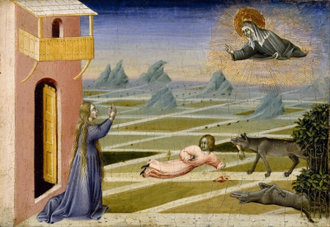Gospel in Art: Feast of Saint Clare

Saint Clare Rescuing a Child Mauled by a Wolf, by Giovanni di Paolo 1455-1460, © The Museum of Fine Arts, Houston / The Strauss Collection
Source: Christian Art
Gospel of 11 August 2023
Matthew 16:24-28
Jesus said to his disciples: 'If anyone wants to be a follower of mine, let him renounce himself and take up his cross and follow me. For anyone who wants to save his life will lose it; but anyone who loses his life for my sake will find it. What, then, will a man gain if he wins the whole world and ruins his life? Or what has a man to offer in exchange for his life?
'For the Son of Man is going to come in the glory of his Father with his angels, and, when he does, he will reward each one according to his behaviour. I tell you solemnly, there are some of these standing here who will not taste death before they see the Son of Man coming with his kingdom.'
Reflection on the painting
Today we celebrate the Feast of Saint Clare. Clare of Assisi (1194-1253) was one of the first followers of Saint Francis of Assisi and founded the Order of Poor Ladies as it was called first. The Order of Poor Ladies was different from any other order or convent that had existed before then, as it followed a rule of strict poverty. Clare wrote their Rule of Life, the first set of monastic guidelines known to have been written by a woman. Following her death, the order she founded was renamed in her honour as the Order of Saint Clare, commonly referred to today as the Poor Clares.
Our mid 15th century painting by Giovanni di Paolo illustrates a miracle performed by Saint Clare. She appears in a large golden halo and burst of light (upper right corner) to the woman praying for help for her poor child, mauled by a wolf, seen at the centre of the composition. Following a medieval painterly tradition called "simultaneous narration," the wolf that attacked the child is seen twice, once alive with the child's arm in his mouth, and again struck dead in the foreground. The story represented here follows the biography of the saint attributed to Tommaso da Celano (1185-1260), but it has been reduced to a minimum of narrative elements. The dramatically gesturing figures with their flowing, wavy hair are characteristic of Giovanni di Paolo.
In art, Clare is more often shown carrying a monstrance or pyx, in commemoration of the occasion when she warded away the invading soldiers of Frederick II at the gates of her convent by displaying the Blessed Sacrament and kneeling in prayer.
Saint Clare truly lived today's Gospel reading 'Anyone who loses his life for my sake will find it'. Saint Clare, pray for us.
LINKS
Gospel in Art: https://christian.art/
Today's reflection: https://christian.art/daily-gospel-reading/matthew-16-24-28-2023/


















